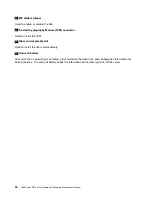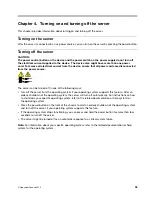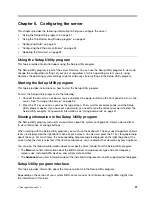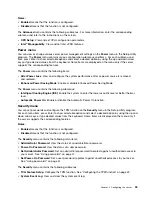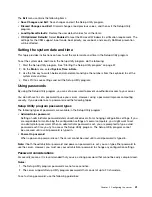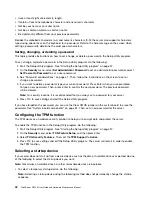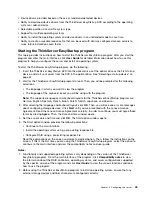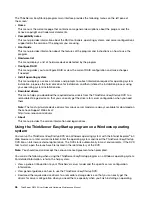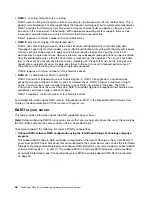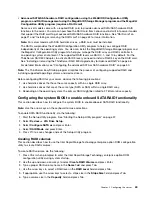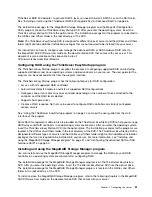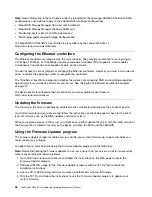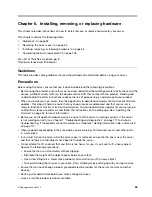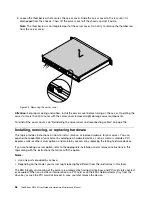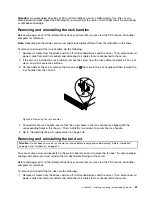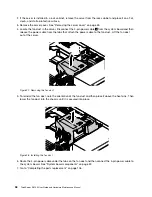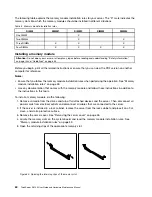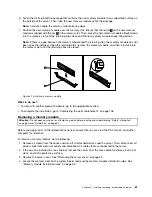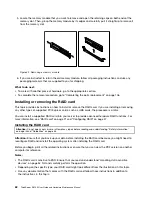
•
RAID 1
: mirroring without parity or striping
RAID 1 uses mirroring so that data written to one drive is simultaneously written to another drive. This is
good for small databases or other applications that require small capacity but complete data redundancy.
RAID 1 provides fault tolerance from disk errors or failures and continues to operate as long as at least
one drive in the mirrored set is functioning. With appropriate operating system support, there can be
increased read performance and only a minimal write performance reduction.
RAID 1 requires a minimum number of two hard disk drives.
•
RAID 5
: block-level striping with distributed parity
RAID 5 uses disk striping and parity data across all drives (distributed parity) to provide high data
throughput, especially for small random access. RAID 5 distributes parity along with the data and requires
all drives but one to be present to operate; drive failure requires replacement, but the array is not
destroyed by a single drive failure. Upon drive failure, any subsequent read operations can be calculated
from the distributed parity so that the drive failure is masked from the end user. The array will have data
loss in the event of a second drive failure and is vulnerable until the data that was on the failing drive is
rebuilt onto a replacement drive. A single drive failure in the set will result in reduced performance of
the entire set until the failing drive has been replaced and rebuilt.
RAID 5 requires a minimum number of three hard disk drives.
•
RAID 10
: a combination of RAID 0 and RAID 1
RAID 10 consists of striped data across mirrored spans. A RAID 10 drive group is a spanned drive
group that creates a striped set from a series of mirrored drives. RAID 10 allows a maximum of eight
spans. You must use an even number of drives in each RAID virtual drive in the span. The RAID 1
virtual drives must have the same stripe size. RAID 10 provides high data throughput and complete data
redundancy but uses a larger number of spans.
RAID 10 requires a minimum number of four hard disk drives.
For detailed information about RAID, refer to “Introduction to RAID” in the
MegaRAID SAS Software User
Guide
on the documentation DVD that comes with your server.
RAID for your server
This topic provides information about the RAID supported by your server.
Note:
Before configuring RAID for your server, ensure that you use hard disk drives that are of the same type
(SATA or SAS) and have the same capacity within a single RAID array.
Your server supports the following two types of RAID configurations:
•
Onboard SATA software RAID configuration using the Intel Rapid Storage Technology enterprise
program
The onboard SATA software RAID controller is integrated on the Intel C226 chip on the system board. If
your server has SATA hard disk drives that are connected to the system board, you can use the Intel Rapid
Storage Technology enterprise program to configure RAID. By default, your server supports onboard SATA
software RAID levels 0, 1, 5, and 10. The onboard RAID is a software RAID instead of a hardware RAID.
For detailed information, see “Configuring the system BIOS to enable onboard SATA RAID functionality”
on page 49.
48
ThinkServer RS140 User Guide and Hardware Maintenance Manual
Summary of Contents for ThinkServer RS140
Page 16: ...4 ThinkServer RS140 User Guide and Hardware Maintenance Manual ...
Page 18: ...6 ThinkServer RS140 User Guide and Hardware Maintenance Manual ...
Page 48: ...36 ThinkServer RS140 User Guide and Hardware Maintenance Manual ...
Page 122: ...110 ThinkServer RS140 User Guide and Hardware Maintenance Manual ...
Page 128: ...116 ThinkServer RS140 User Guide and Hardware Maintenance Manual ...
Page 132: ...120 ThinkServer RS140 User Guide and Hardware Maintenance Manual ...
Page 145: ......
Page 146: ......

